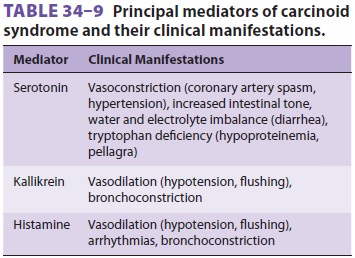Chapter: Clinical Anesthesiology: Anesthetic Management: Anesthesia for Patients with Endocrine Disease
Anesthesia for Carcinoid Syndrome
Carcinoid Syndrome
Carcinoid syndrome is the complex of symptoms and signs caused by the secretion of vasoactive substances (eg, serotonin, kallikrein, histamine) from entero-epinephrine tumors (carcinoid tumors). Because most of these tumors are located in the gastroin-testinal tract, their metabolic products are released into the portal circulation and destroyed by the liver before they can cause systemic effects. However, the products of nonintestinal tumors (eg, pulmonary, ovarian) or hepatic metastases bypass the portal cir-culation and, therefore, can cause a variety of clini-cal manifestations. Many patients undergo surgery for resection of carcinoid tumors; most such patients have not experienced carcinoid syndrome.
Clinical Manifestations
The most common manifestations of carcinoid
syndrome are cutaneous flushing, bronchospasm, profuse diarrhea, dramatic
swings in arterial blood pressure (usually hypotension), and supraventricu-lar
arrhythmias (Table 34–9). Carcinoid syndrome is associated with right-sided
heart disease caused by valvular and myocardial plaque formation, and, in some
cases, implantation of tumors on the tricuspid and pulmonary valves. The
diagnosis of carcinoid syndrome is confirmed by detection of serotonin
metabolites in the urine (5-hydroxyin-doleacetic acid) or suggested by elevated
plasma lev-els of chromogranin A. Treatment varies depending on tumor
location but may include surgical resec-tion, symptomatic relief, or specific serotonin and histamine antagonists. Somatostatin, an
inhibitory peptide, reduces the release of vasoactive tumor products.

Anesthetic Considerations
The key to perioperative management of
patients with carcinoid syndrome is toavoid anesthetic and surgical techniques
or agents that could cause the tumor to release vasoactive substances. Regional
anesthesia may limit release of stress hormones perioperatively. Large bolus
doses of histamine-releasing drugs (eg, morphine and atracurium) should be
avoided. Surgical manipu-lation of the tumor can cause a massive release of
hormones. Monitoring likely will include an arterial line. If there are concerns
about hemodynamic insta-bility or intrinsic heart disease caused by carcinoid
syndrome, transesophageal echocardiography may be helpful. Alterations in
carbohydrate metabolism may lead to unsuspected hypoglycemia or hypergly-cemia.
Consultation with an endocrinologist may help clarify the role of
antihistamine, antiserotonin drugs (eg, methysergide), octreotide (a
long-acting somatostatin analogue), or antikallikrein drugs (eg,
corticosteroids) in specific patients.
Related Topics